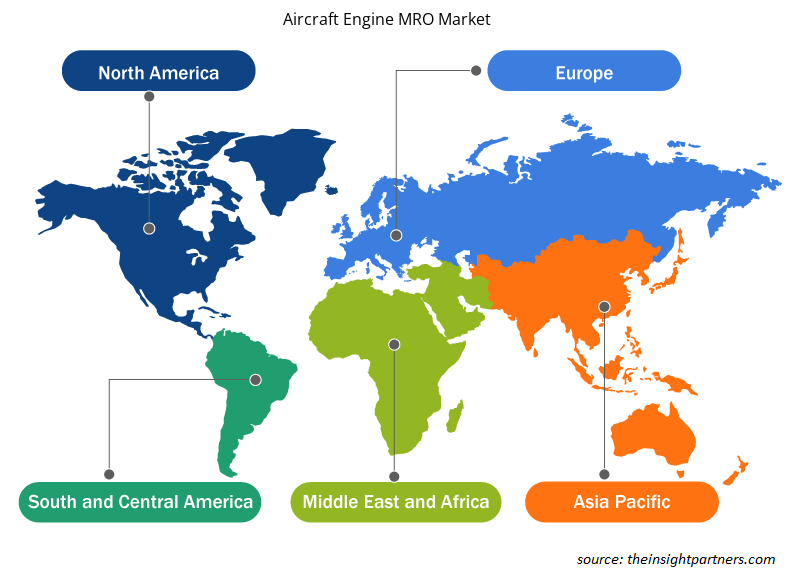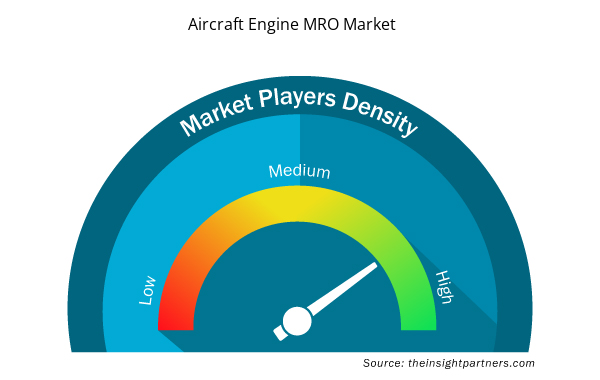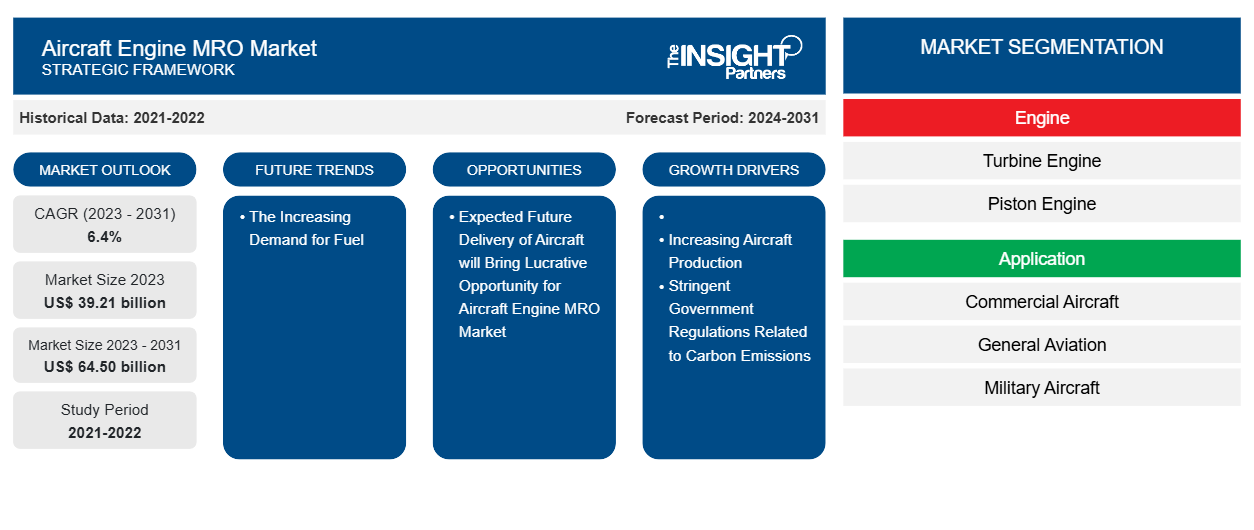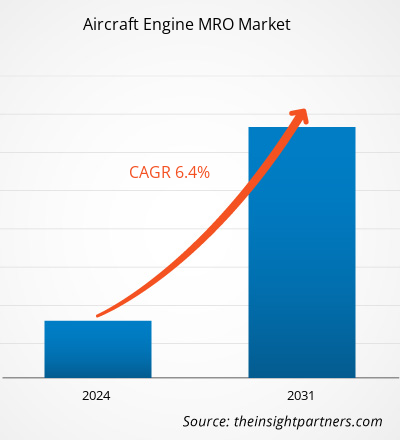航空機エンジンMRO市場規模は、2023年の392.1億米ドルから2031年には645億米ドルに達すると予測されています。市場は2023年から2031年にかけて6.4%のCAGRを記録すると予想されています。燃費の良い航空機に対する需要の増加は、航空機エンジンMRO市場の主要なトレンドであり続けると思われます。
航空機エンジンMRO市場分析
世界中の空港には、さまざまな種類のエンジン MRO 施設があります。一般的に、メンテナンスは航空機の機体またはエンジンに対して行われます。エンジン MRO サービスには、現在ではコンポーネントの MRO も含まれます。サービスの種類に応じて、これらのサービスは空港で提供されますが、空港外の施設で提供される場合もあります。定期検査、定期的なトラブルシューティング、または日々のエンジン チェックなどの作業は、航空機が空港ターミナルに駐機しているときに行うことができます。
航空機エンジンMRO市場の概要
航空機エンジンの MRO の主な用途の 1 つは、エンジンのすべての回転ステージのバランスを保ち、振動レベルを最小限に抑えることです。これにより、エンジンの耐久性と燃料効率が向上し、振動によるエンジンの摩耗量が制限されます。航空機エンジンとそれに関連するコンポーネントをアップグレードすることで、航空機エンジンの MRO のための高度なインフラストラクチャと熟練した労働力の必要性も高まります。エンジンの MRO 要件は、エンジンの種類とカテゴリによって異なります。古くて小型の航空機エンジンのオーバーホール間隔 (TBO) は最大 5,000 時間です。最新のエンジンの TBO は 6,000 時間を超えます。年間飛行時間が 500 時間未満のビジネス ジェット機が増えているため、エンジン MRO サービスの要件は平均 12 年以上です。
要件に合わせてレポートをカスタマイズする
このレポートの一部、国レベルの分析、Excelデータパックなど、あらゆるレポートを無料でカスタマイズできます。また、スタートアップや大学向けのお得なオファーや割引もご利用いただけます。
- このレポートの主要な市場動向を入手してください。この無料サンプルには、市場動向から見積もりや予測に至るまでのデータ分析が含まれます。
航空機エンジンMRO市場の推進要因と機会
炭素排出に関する厳格な政府規制
2021年、米国政府は2030年までに航空機の排出量を20%削減するという目標を発表しました。いくつかの規制当局は、炭素排出量を削減するための戦略を実施しています。たとえば、2022年3月、国際航空運送協会(IATA)は、2050年までに年間100億回以上の飛行が飛行機で行われると推定し、2050年までに炭素排出量を実質ゼロにすることを発表しました。
世界の60%以上の国が、ネットゼロ炭素排出を宣言しています。ハネウェル・エアロスペースなどの企業も、2035年までにネットゼロ炭素排出を達成することを約束しています。2021年11月、ベル・テキストロン社は、ベル525が持続可能な航空燃料を使用して最初の飛行を完了したと発表しました。ボーイングとエアバスは最近、2030年までに航空機が100%持続可能な燃料で飛行することを発表しました。米国と欧州の政府は、持続可能な燃料の製造を奨励しています。これらの要因により、航空機エンジンMRO市場が大幅に推進されています。
民間航空機の今後の納入予測 - 航空機エンジンMRO市場におけるチャンス
航空交通量と航空機需要の増加に伴い、航空会社は航空機の納入を増やしています。新しい航空会社の需要は、既存の航空機の艦隊再構築だけでなく、市場に参入する新しい低コストの航空機からも生じています。パンデミック後にコストに敏感になったレジャー旅行者の抑制された関心、ビジネス旅行への関心の低下、および最小限の費用の航空機行動計画の適応性により、MROサービスの需要が急増しています。さらに、ボーイングとエアバスの予測によると、2042年末までに40,800機以上の商用航空機が納入されると予想されており、これらの航空機生産への新しいエンジンの導入がさらに促進されます。これにより、世界的に航空機艦隊全体がさらに増加し、今後数年間でエンジンMROと市場ベンダーの需要が生まれます。
航空機エンジンMRO市場レポートのセグメンテーション分析
航空機エンジン MRO 市場分析の導出に貢献した主要なセグメントは、エンジン、アプリケーション、および航空機の種類です。
エンジン [タービンエンジン (ターボプロップエンジン、ターボファンエンジン、ターボシャフトエンジン)、ピストンエンジン]、用途 (民間航空機、一般航空、軍用航空機)、航空機タイプ (固定翼、回転翼)
- エンジンに基づいて、航空機エンジンMRO市場はタービンエンジンとピストンエンジンに分類されます。また、タービンエンジンは、ターボプロップエンジン、ターボファンエンジン、ターボシャフトエンジンにさらに細分化されています。タービンエンジンセグメントは、2023年に大きな市場シェアを占めました。
- 用途に基づいて、市場は民間航空機、一般航空、軍用航空機に分類されます。民間航空機セグメントは2023年に大きな市場シェアを占めました。
- 航空機の種類に基づいて、市場は固定翼と回転翼に分割されています。固定翼セグメントは2023年に大きな市場シェアを占めました。
航空機エンジンMRO市場シェアの地域別分析
航空機エンジン MRO 市場レポートの地理的範囲は、主に北米、アジア太平洋、ヨーロッパ、中東およびアフリカ、南米の 5 つの地域に分かれています。
2023年には、アジア太平洋地域が世界の航空機エンジンMRO市場の大部分を占め、北米とヨーロッパがそれに続きます。アジアの経済は、多様な所得水準と急速に拡大する中流階級によって牽引されてきました。その結果、インドや中国など、この地域の急成長している経済圏で力強い売上成長が見られました。アジア太平洋地域は、航空機MROサービスプロバイダーにとって最も有望な市場になると予測されています。この地域には、航空宇宙、軍事・防衛、テクノロジーなど、さまざまな産業で先頭に立っている発展途上国がいくつかあります。アジア太平洋地域の多くの成長経済国は、技術を向上させるために規制投資を求めています。これは最終的に、航空機統合のための新技術の開発と使用を促進するでしょう。シンガポール航空やマレーシア航空など、アジア太平洋地域のいくつかの航空会社は、社内メンテナンス機能を開発しています。米国を拠点とする航空宇宙企業であるプラット・アンド・ホイットニーは、2019年にシンガポールのイーグル・サービス・アジア工場でPW100G-JMギアード・ターボファンのMRO機能を追加しました。この工場では長年にわたり、プラット・アンド・ホイットニーGTFエンジンのオーバーホールを行ってきました。PW100G-JMエンジンの発売により、この施設では、PW100G-JMを使用するさまざまな航空機オペレーターからの収益が大幅に増加すると予想されています。さらに、改良された航空機向けの改造技術の導入の増加とブロックチェーン技術の採用の急増は、航空機エンジンMRO市場の成長を促進する主な要因の1つです。また、アジア太平洋地域での市場の成長は、旅客数の増加による航空機群の増加、国防予算の増加に伴う軍用機への支出の増加、商用、一般航空、軍用機の開発の進行中のプロジェクトに起因しています。
航空機エンジンMRO市場の地域別分析
予測期間を通じて航空機エンジン MRO 市場に影響を与える地域的な傾向と要因は、Insight Partners のアナリストによって徹底的に説明されています。このセクションでは、北米、ヨーロッパ、アジア太平洋、中東およびアフリカ、南米および中米にわたる航空機エンジン MRO 市場のセグメントと地理についても説明します。

- 航空機エンジンMRO市場の地域別データを入手
航空機エンジンMRO市場レポートの範囲
| レポート属性 | 詳細 |
|---|---|
| 2023年の市場規模 | 392.1億米ドル |
| 2031年までの市場規模 | 645億ドル |
| 世界のCAGR(2023年~2031年) | 6.4% |
| 履歴データ | 2021-2022 |
| 予測期間 | 2024-2031 |
| 対象セグメント | エンジン別
|
| 対象地域と国 | 北米
|
| 市場リーダーと主要企業プロフィール |
|
市場プレーヤーの密度:ビジネスダイナミクスへの影響を理解する
航空機エンジン MRO 市場は、消費者の嗜好の変化、技術の進歩、製品の利点に対する認識の高まりなどの要因により、エンドユーザーの需要が高まり、急速に成長しています。需要が高まるにつれて、企業は提供内容を拡大し、消費者のニーズを満たすために革新し、新たなトレンドを活用し、市場の成長をさらに促進しています。
市場プレーヤー密度とは、特定の市場または業界内で活動している企業または会社の分布を指します。これは、特定の市場スペースに、その市場規模または総市場価値に対してどれだけの競合相手 (市場プレーヤー) が存在するかを示します。
航空機エンジンMRO市場で事業を展開している主要企業は次のとおりです。
- デルタ航空
- GEアビエーション
- CFMインターナショナル
- ルフトハンザ テクニック
- MTUエアロエンジンAG
- SIAエンジニアリング株式会社
免責事項:上記の企業は、特定の順序でランク付けされていません。

- 航空機エンジンMRO市場の主要な主要プレーヤーの概要を入手
航空機エンジンMRO市場のニュースと最近の動向
航空機エンジン MRO 市場は、主要な企業出版物、協会データ、データベースなどの一次調査と二次調査後の定性的および定量的データを収集することで評価されます。以下は、イノベーション、ビジネス拡大、戦略に関する市場の開発のリストです。
- 2024年4月、ITPエアロはコロンビア国防省と、同国軍のブラックホークヘリコプター群に搭載されるT700エンジンの保守、修理、オーバーホール(MRO)に関する契約を締結した。契約は2026年6月までで、エンジンのMROサービスはアルバセテ(スペイン)にあるITPエアロの施設で実施される。(出典:ITPエアロ、プレスリリース)
- 2023年11月、MTUメンテナンスはスリランカ航空と5年間のLEAP-1Aメンテナンス、修理、オーバーホール(MRO)契約を締結しました。これは、V2500エンジンとリースサポートもカバーする両社の既存の関係をさらに強化するものです。スリランカの国営航空会社は現在、エアバスA330とA320/A321の航空機22機を運航しており、南アジア、ヨーロッパ、極東、中東を飛行しています。(出典:MTUメンテナンス、ニュースレター)
航空機エンジンMRO市場レポートの対象範囲と成果物
「航空機エンジンMRO市場規模と予測(2021〜2031年)」レポートでは、以下の分野をカバーする市場の詳細な分析を提供しています。
- 航空機エンジンMRO市場規模と予測(世界、地域、国レベルで)
- 市場の動向(推進要因、制約、主要な機会など)
- 航空機エンジンMRO市場の動向
- ポーターの5つの力の詳細
- 航空機エンジンMRO市場分析では、主要な市場動向、世界および地域の枠組み、主要プレーヤー、規制、最近の市場動向を網羅しています。
- 航空機エンジンMRO業界の展望と競争分析、市場集中、ヒートマップ分析、主要プレーヤー、最近の動向
- 詳細な企業プロフィール
- 過去2年間の分析、基準年、CAGRによる予測(7年間)
- PEST分析とSWOT分析
- 市場規模価値/数量 - 世界、地域、国
- 業界と競争環境
- Excel データセット



Report Coverage
Revenue forecast, Company Analysis, Industry landscape, Growth factors, and Trends

Segment Covered
This text is related
to segments covered.

Regional Scope
North America, Europe, Asia Pacific, Middle East & Africa, South & Central America

Country Scope
This text is related
to country scope.
Trends and growth analysis reports related to Aerospace and Defense : READ MORE..
The Insight Partners performs research in 4 major stages: Data Collection & Secondary Research, Primary Research, Data Analysis and Data Triangulation & Final Review.
- Data Collection and Secondary Research:
As a market research and consulting firm operating from a decade, we have published and advised several client across the globe. First step for any study will start with an assessment of currently available data and insights from existing reports. Further, historical and current market information is collected from Investor Presentations, Annual Reports, SEC Filings, etc., and other information related to company’s performance and market positioning are gathered from Paid Databases (Factiva, Hoovers, and Reuters) and various other publications available in public domain.
Several associations trade associates, technical forums, institutes, societies and organization are accessed to gain technical as well as market related insights through their publications such as research papers, blogs and press releases related to the studies are referred to get cues about the market. Further, white papers, journals, magazines, and other news articles published in last 3 years are scrutinized and analyzed to understand the current market trends.
- Primary Research:
The primarily interview analysis comprise of data obtained from industry participants interview and answers to survey questions gathered by in-house primary team.
For primary research, interviews are conducted with industry experts/CEOs/Marketing Managers/VPs/Subject Matter Experts from both demand and supply side to get a 360-degree view of the market. The primary team conducts several interviews based on the complexity of the markets to understand the various market trends and dynamics which makes research more credible and precise.
A typical research interview fulfils the following functions:
- Provides first-hand information on the market size, market trends, growth trends, competitive landscape, and outlook
- Validates and strengthens in-house secondary research findings
- Develops the analysis team’s expertise and market understanding
Primary research involves email interactions and telephone interviews for each market, category, segment, and sub-segment across geographies. The participants who typically take part in such a process include, but are not limited to:
- Industry participants: VPs, business development managers, market intelligence managers and national sales managers
- Outside experts: Valuation experts, research analysts and key opinion leaders specializing in the electronics and semiconductor industry.
Below is the breakup of our primary respondents by company, designation, and region:

Once we receive the confirmation from primary research sources or primary respondents, we finalize the base year market estimation and forecast the data as per the macroeconomic and microeconomic factors assessed during data collection.
- Data Analysis:
Once data is validated through both secondary as well as primary respondents, we finalize the market estimations by hypothesis formulation and factor analysis at regional and country level.
- Macro-Economic Factor Analysis:
We analyse macroeconomic indicators such the gross domestic product (GDP), increase in the demand for goods and services across industries, technological advancement, regional economic growth, governmental policies, the influence of COVID-19, PEST analysis, and other aspects. This analysis aids in setting benchmarks for various nations/regions and approximating market splits. Additionally, the general trend of the aforementioned components aid in determining the market's development possibilities.
- Country Level Data:
Various factors that are especially aligned to the country are taken into account to determine the market size for a certain area and country, including the presence of vendors, such as headquarters and offices, the country's GDP, demand patterns, and industry growth. To comprehend the market dynamics for the nation, a number of growth variables, inhibitors, application areas, and current market trends are researched. The aforementioned elements aid in determining the country's overall market's growth potential.
- Company Profile:
The “Table of Contents” is formulated by listing and analyzing more than 25 - 30 companies operating in the market ecosystem across geographies. However, we profile only 10 companies as a standard practice in our syndicate reports. These 10 companies comprise leading, emerging, and regional players. Nonetheless, our analysis is not restricted to the 10 listed companies, we also analyze other companies present in the market to develop a holistic view and understand the prevailing trends. The “Company Profiles” section in the report covers key facts, business description, products & services, financial information, SWOT analysis, and key developments. The financial information presented is extracted from the annual reports and official documents of the publicly listed companies. Upon collecting the information for the sections of respective companies, we verify them via various primary sources and then compile the data in respective company profiles. The company level information helps us in deriving the base number as well as in forecasting the market size.
- Developing Base Number:
Aggregation of sales statistics (2020-2022) and macro-economic factor, and other secondary and primary research insights are utilized to arrive at base number and related market shares for 2022. The data gaps are identified in this step and relevant market data is analyzed, collected from paid primary interviews or databases. On finalizing the base year market size, forecasts are developed on the basis of macro-economic, industry and market growth factors and company level analysis.
- Data Triangulation and Final Review:
The market findings and base year market size calculations are validated from supply as well as demand side. Demand side validations are based on macro-economic factor analysis and benchmarks for respective regions and countries. In case of supply side validations, revenues of major companies are estimated (in case not available) based on industry benchmark, approximate number of employees, product portfolio, and primary interviews revenues are gathered. Further revenue from target product/service segment is assessed to avoid overshooting of market statistics. In case of heavy deviations between supply and demand side values, all thes steps are repeated to achieve synchronization.
We follow an iterative model, wherein we share our research findings with Subject Matter Experts (SME’s) and Key Opinion Leaders (KOLs) until consensus view of the market is not formulated – this model negates any drastic deviation in the opinions of experts. Only validated and universally acceptable research findings are quoted in our reports.
We have important check points that we use to validate our research findings – which we call – data triangulation, where we validate the information, we generate from secondary sources with primary interviews and then we re-validate with our internal data bases and Subject matter experts. This comprehensive model enables us to deliver high quality, reliable data in shortest possible time.


 このレポートの無料サンプルを入手する
このレポートの無料サンプルを入手する